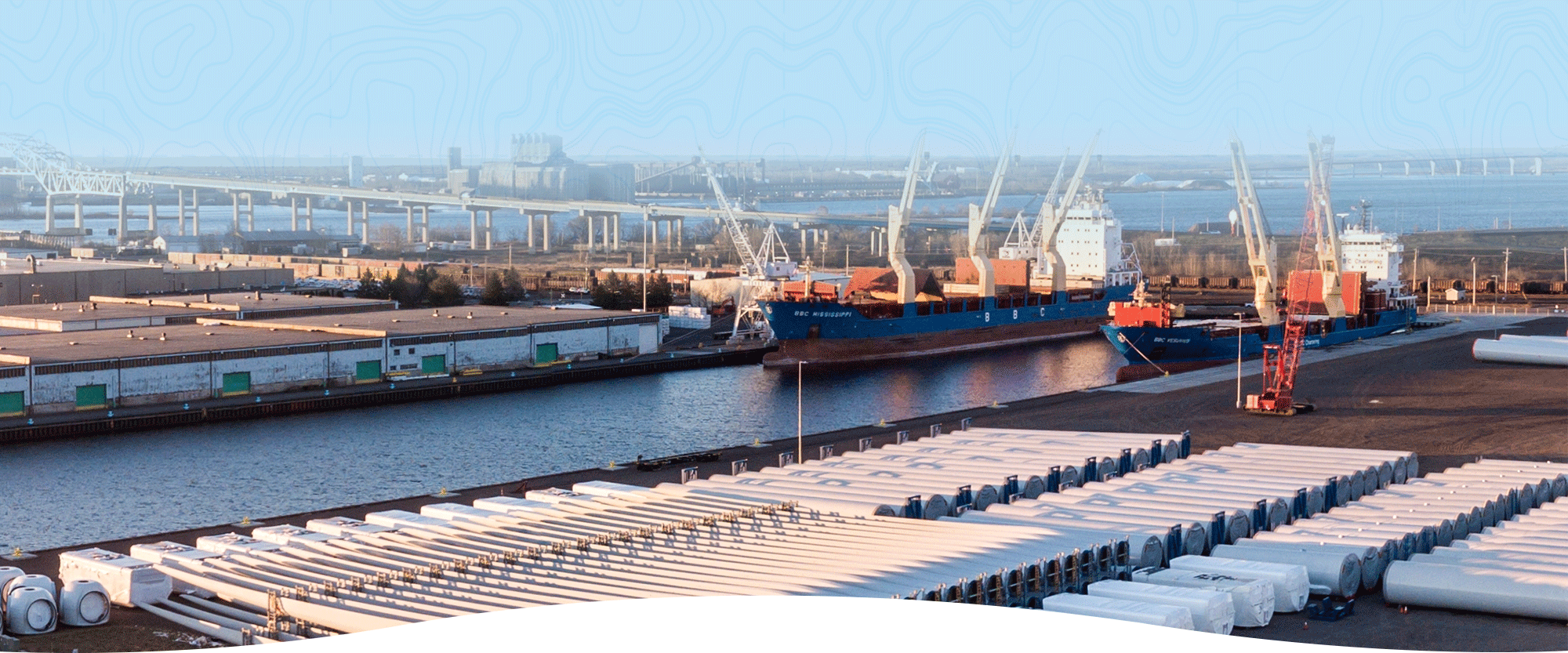Harboring a proud place in history.
The Port of Duluth-Superior sits at the westernmost tip of the Great Lakes-St. Lawrence Seaway – 2,342 miles from the Atlantic Ocean. It’s where the St. Louis River fans out to create a natural harbor, sheltered from Lake Superior by a narrow peninsula that stretches nine miles from Minnesota to Wisconsin.
For generations, native people navigated these waters. Later, French-Canadian voyageurs and other Europeans used Lake Superior as a transportation artery. American and Canadian mining companies capitalized on this inland trade route when the first locks opened at Sault Ste. Marie, Michigan.
Beginning in the 1800s, the Port of Duluth-Superior made its mark as a mid-continent transportation hub. Among its earliest cargoes were lumber, bulk grain, coal, iron ore and ‘walking cargo’ as immigrants, businessmen and tourists arrived on passenger ships. In 1871, the Duluth Ship Canal opened, and soon commercial shipping vessels transited the canal carrying goods to and from distant ports.
Like all world-class ports, Duluth-Superior has undergone tremendous change over the years.
When the Great Lakes-St. Lawrence Seaway opened to deep-draft navigation in 1959, this marine corridor became the world’s largest inland waterway. Today, new and renovated port facilities have allowed the next generation of ships to load and unload at incredible speeds. The Port of Duluth-Superior is evolving, growing and adapting to the ever-advancing technologies and market forces of the 21st Century.
Pride of the Inland Seas
Pride of the Inland Seas: An Illustrated History of the Port of Duluth-Superior tells the tale of the Twin Ports’ development during three centuries of economic, technological, political and social change. This is the story of those who built, loaded and sailed the ships that made Duluth-Superior synonymous with Great Lakes maritime commerce.
Authors Bill Beck and C. Patrick Labadie bring lifetimes of Great Lakes experience to the pages of Pride of the Inland Seas, published in collaboration with the Duluth Seaway Port Authority, July 2004. The foreword is written by former Port Director Davis Helberg.
For additional stories of our Port’s history, be sure to read Pride of the Inland Seas: Companion Stories available for download below.
Readers may save these stories for future enjoyment or reference, but please note that the stories and images are copyrighted and cannot be reproduced in any form for personal gain.
Early Port Timeline
Pre-1800s
Bay used by native people for hunting, fishing, dwelling and trade.
Early 1800s
French-Canadian voyageur fur trading emerges at the turn of the century. A trading post is established near what would become the city of Duluth.
1830s
The fur trade declines. Commercial fishing intensifies, using many of the former fur trade posts.
1840s
Geologists and surveyors begin arriving to explore the area’s timber, mineral and agricultural potential.
1854
The tiny village of Duluth formed one year after the founding of Superior City, Wisconsin. Between the two tiny settlements was the finest natural harbor on Lake Superior.
1855
First locks opened at Sault Ste. Marie, Michigan, opening the vast resources of Lake Superior to commercial development.
1858
The harbor’s first lighthouse is lit at Minnesota Point. Harbor improvements begin, boosted by federal appropriations.
1869
The scow schooner Chaska sails as the first large ship built at the Head of the Lakes.
1870
Duluth welcomes its first train arrival on the newly completed Lake Superior & Mississippi Railroad; the port earns recognition as a mid-continent trading hub.
1871
Duluth Ship Canal opens. First shipment of bulk grain departs from Duluth’s first grain elevator. First inbound shipments of coal arrive. Package freight also begins arriving in the form of farm implements, groceries, hardware and building materials for a growing town.
1888
Alexander McDougall builds his first “whaleback” ship, Barge 101, in Duluth.
1891
Grain elevators in the Duluth-Superior harbor surpass 1 million short tons shipped.
1892
The Duluth, Missabe & Northern railroad reaches Duluth-Superior with its first trainload of Mesabi Range iron ore, signaling the dawn of ore shipping through the port. Lumber shipping also emerges in force.
1900
The port tops 5 million tons of iron ore shipped; nearly two-thirds of the cargo transiting the port is iron ore or coal. Duluth’s population increases to nearly 53,000, representing a 60% spike in only 10 years.
1902
Nearly 8,000 vessels visit the Port of Duluth-Superior during the navigation season.
1905
15 million tons of iron ore shipped. Duluth constructs its Aerial Ferry Bridge, as it was then known, to span its canal.
1913
30 million tons of iron ore shipped.
1918
Shipbuilding booms in the Port of Duluth-Superior. Additionally, the port ranks behind only New York and Philadelphia in total cargo tonnage shipped.
1920s
The Duluth harbor emerges as a distribution hub for automobiles arriving on ships from automakers in Detroit, Michigan.
1939
98 wharves or terminals lined the Duluth-Superior harbor, including 7 ore docks, 21 coal docks and 11 grain elevator complexes.
1942
The Port of Duluth-Superior serves as a crucial piece of America’s war effort, transporting a then-record 74.3 million short tons of cargo during the 1942 navigation season. The total float included 63 million tons of iron ore to help build armored vehicles, ships and aircraft.
1953
Total single-season tonnage exceeds 77 million short tons, a Duluth-Superior record that still stands. Of that total, iron ore comprised nearly 65 million short tons.
1959
The St. Lawrence Seaway opened to deep-draft navigation, allowing oceangoing vessels to sail from overseas ports to Duluth-Superior. The Ramon de Larrinaga becomes the first such vessel to arrive, sailing under Duluth’s Aerial Lift Bridge on May 3. Also, the Duluth Seaway Port Authority opened its Clure Public Marine Terminal.



